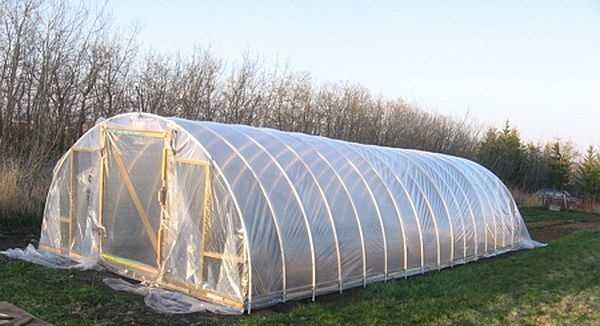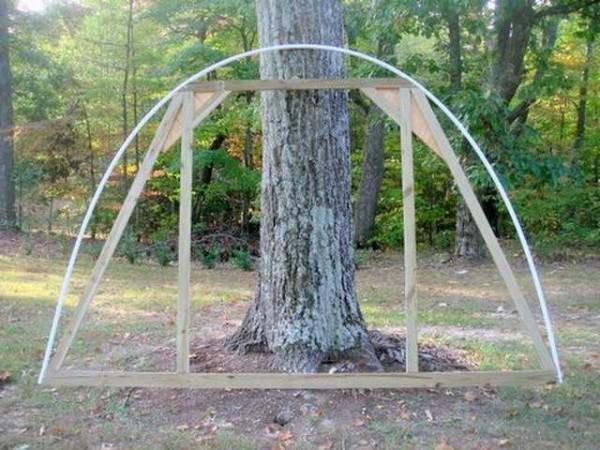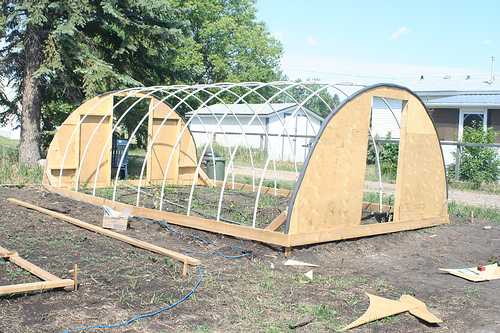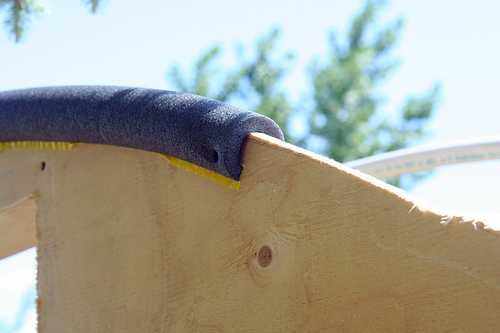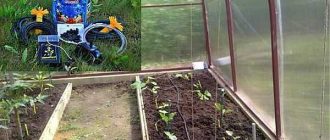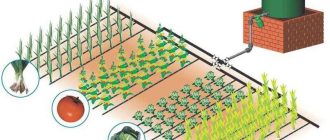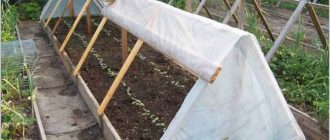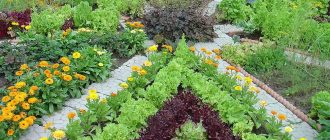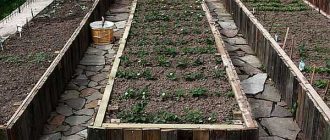Not all regions can do without a greenhouse or a greenhouse at the dacha and in the vegetable garden: in the north the summer is too cool and short, so we have to lengthen it. Yes, and in the more southern regions, then seedlings to grow, then early/late vegetables and berries to get. That is why these structures are popular: the cost is not very large, and a lot of use. And greenhouses and greenhouses with their own hands you can build any design, of any material, for any task.
Let’s immediately stipulate what is different between a greenhouse and a greenhouse. Greenhouse is served from the outside. It has small dimensions and it will not be possible to go into it. Greenhouse – this is already a more solid construction, in which you can stand in full height and work. Plants in it are served from the inside. Here, in fact, all the difference.
Съдържание на статията
Designs of greenhouses and greenhouses
Despite the obvious difference in size, the designs used are the same. The main ones are several, as well as many combinations and modifications.
The main constructive differences are in the shape of the roof. There are three of them:
- arc-shaped;
- single-pitched;
- gable.

From what to make the frame for greenhouses and greenhouses
The choice of materials is wide, and they are often combined. So, the frame of a greenhouse or greenhouse is made of:
- wood (timber or planks);
- metal:
- round and square pipe;
- angle;
- galvanized metal profiles;
- rebar.
- plastic:
Probably everyone knows about the advantages and disadvantages of metal and wood. But what is good and bad plastics, probably few. Plastics are good because they bend well, their outer surface is initially smooth and does not require processing, it does not tear the covering material. Plastic pipes are round, there are square, their wall is thick enough and strong enough to hold self-tapping screws. Their main advantage: they are chemically neutral, do not bloom, do not rust, do not rot. Another of their properties is lightness. Regarding the construction of greenhouses, this is both an advantage and disadvantage. On the one hand, the construction is light, it is easy to assemble and disassemble. But in case of strong wind, lightness is already a disadvantage. It is neutralized by a good base to which the frame is securely fastened.
What to cover with
The main covering material for greenhouses and greenhouses is a film. It is used both on small and solid in size structures. For year-round use, glass used to be used, but its high price and fragility led to the fact that it is used very rarely – it is an expensive shelter. And the heavy weight of glazing requires a solid frame.
There are two new products. More familiar polycarbonate, which is used for gazebos and sheds, and relatively new – non-woven covering material spunbond.
Now about all of them in detail.
Film for greenhouses and greenhouses
Produced from different polymers, has different thicknesses. The most common are polyethylene, polyvinyl chloride. There are also reinforced.
Polyethylene films are the most inexpensive, but they are also the most short-lived. Even with the most careful attitude more than a year they do not serve: they become brittle under the influence of ultraviolet light, and make them cold. Nevertheless, more often buy them: cheap.
Produced in the form of a sleeve. Cutting it on one side, we get a double width. Use uncut film is not worth it: the service life will remain the same, but the consumption is exactly twice as much. There is only one peculiarity: the film quickly tears along the fold. It is difficult and almost useless to glue it afterwards: scotch tape glues very badly on a dusty surface. That’s why this fold is glued with tape before use. It works reliably.
Thickness and types
The optimal thickness of polyethylene film for dacha greenhouses and greenhouses is 150 microns. Take a thicker – all the same, its service life is one season, and the characteristics and 150 will be enough.
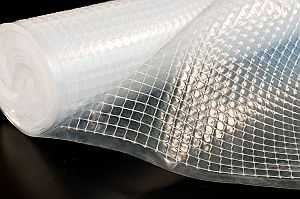
Reinforced film is more durable. Manufacturers give a warranty of 3 years. It can be easily distinguished by its appearance: it is caged. In the cloth of polyethylene fibers of other polymers or the same polyethylene, but processed in a different way. Thanks to stronger fibers such a film greenhouse well withstands wind and snow loads (to a certain extent). Reinforced film there are different densities, for greenhouses and greenhouses in the dachas and homestead plots more suitable 120 g/m2 to 200 g/m2.
There are also polyvinyl chloride films. They can be used for up to 7 years. But they are expensive. The material is also good because it transmits sunlight well (80-90%) and almost does not pass infrared (5-10%), that is, does not let the greenhouse cool down overnight. If you need a warm greenhouse that maintains temperature well at night, this is your choice.
There are also films called perennials. Most often it is polyethylene with different additives. Less often there are some other polymers. Usually, perennial films have some special properties:
- less destroyed by ultraviolet light – light-stabilizing;
- less transmits thermal radiation – heat-stabilizing;
- prevents condensation drops from forming on the film – hydrophilic;
- reflects thermal radiation, glows in the dark, absorbs ultraviolet – these properties depend on the type of additives, but are called light converting.
These properties can be combined in a single film. So you can find a perennial hydrophilic heat-stabilizing film, etc. Another point. Such films usually have some kind of hue: yellow, greenish, blue…..
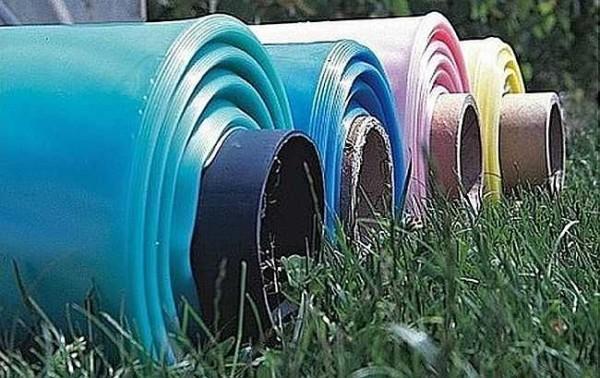
When choosing a perennial film, be sure to specify its service life. It can be from two seasons to 3 years. Pay attention. If it is written 2 seasons, it means that it should be removed for the winter. If 2 years, it is a film for year-round use. Sellers often manipulate these concepts, saying that two seasons is two years.
Photo reports on the construction of greenhouses with their own hands see here.
Polycarbonate
This cellular material has many advantages: it is lightweight, transmits light well, retains heat, bends, is easy to install. The disadvantage is the relatively high cost. Nevertheless, if the greenhouse will be used for more than one year, such investments will pay off: even without additional heating, the growing season is significantly increased.
But polycarbonate is different in structure and thickness. The most commonly used types in the construction of greenhouses are in the table.
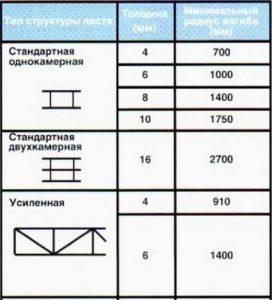
For normal conditions (average snow load and winds) is used to cover greenhouses single-chamber sheets. For regions with a lot of snow, it makes sense to take reinforced.
The thickness of the sheets is optimal – 6 mm or 8 mm. Less should not be taken: too fragile sheets and their characteristics are not very good (see table). Polycarbonate thickness of 4 mm can be put on small greenhouses. Large loads it will not withstand.
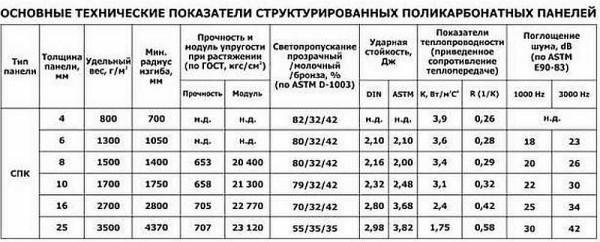
Polycarbonate still need to be properly fastened: the cells should be oriented from top to bottom, the open edges should be sealed with special tape or scotch tape, fasten with special thermal washers or bolts with a large metal washer, under which it is necessary to put a rubber or plastic pad.
Spunbond
This has long been more than one material. There are many brands: Agril, Lutrasil, Spantex, Agrospan, AgroSUF, etc. Just Spunbond appeared first and now all similar materials are called just so, and also “nonwoven covering material” or “agrovolokno”. This non-woven polypropylene fiber, which has unique characteristics: it lets air, light and moisture, while saving plants from overheating or freezing. Feedback from the practice of using this material in the video.
Agrofiber is characterized by density. The lowest is 17 kg/m3, the highest is 60 kg/m3. For seasonal greenhouses and greenhouses from spring to fall, the optimal density – 30-40 kg/m3, for winter need 60 kg/m3.
On how to organize drip irrigation read here.
How to quickly build a greenhouse with arcs (with photo-explanations)
As a rule, the first greenhouse at the dacha or in the vegetable garden is made of inexpensive materials: you need to try what it is and assess how profitable the idea is. Hence the requirements: a simple, quick construction from inexpensive, available materials. These requirements fully meet these requirements frame greenhouses with arcs made of PVC pipes (you can use and HDPE).

Материали
Here is such a greenhouse, as in the photo above, can be made in a few hours. You will need the following material:
- Board for the base, the size is not less than 75*40 mm, the length depends on the dimensions of your greenhouse. From the bar knock down the frame, which lies along the perimeter of the greenhouse. If the greenhouse is 6*3 meters, then the bar needs 18 meters, if 8*3 meters, then 24 meters, etc.
- Board with a cross-section of 50*20 mm to organize the entrance door.
- PVC pipes with a wall thickness of at least 2 mm. Length depends on the dimensions of the greenhouse. If you are going to build a greenhouse, then at the top point of its height should be at least 2.2 meters. Then you can easily work inside.
- Armature with a diameter of 14-16 mm. It should be slightly smaller than the inner diameter of PVC pipes.
- Covering material – film or agrofiber. Others will not be suitable for this construction.
- Perforated metal tape.
- Wood screws.
Wood before you use it, treat with means against rot and insects. If there are pieces of bark somewhere, it is necessary to get rid of them. That is where the larvae are most abundant. If there are any factory impregnations, you can use them. If you have used machine oil, it will do. If you do not have it, you can burn the wood with a blowtorch. This method is unreliable, but even this treatment is better than none.
Tools for work
To make a greenhouse for a dacha with your own hands you will need tools:
- hammer, nails;
- wood saw;
- bolgarka with a metal disk;
- sledgehammer or heavy hammer (to hammer in rebar);
- screwdriver.
Build a greenhouse from polypropylene pipes (photo-report)
The first thing is marked, then the site is leveled. It is leveled under the level. Then begins the actual construction of a seasonal greenhouse.
Подготвителна работа
From a wide board, a rectangle is knocked down, which outlines the boundary of the greenhouse. If you know how, the beam can be connected in a paw, if not, just knock through with a hammer and long nails (at least 10 cm). Reinforce the beams with metal plates or corners. Check the base. To find out how level it is, measure the diagonals. If they are equal – great. No – level it. After that, fix the base – in the inner corners, hammer in reinforcement rods. They will hold the base in place.
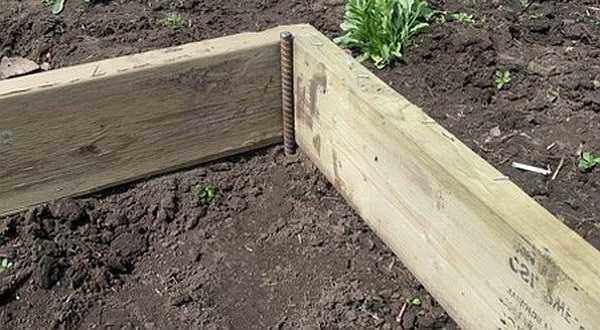
The rebar is cut into pieces about 80 cm long. They are installed every 50 cm on both long sides of the greenhouse. 40 cm are driven into the ground and the same amount is left sticking out. The bars of the opposite sides must stand strictly one opposite the other, otherwise the greenhouse will be skewed.
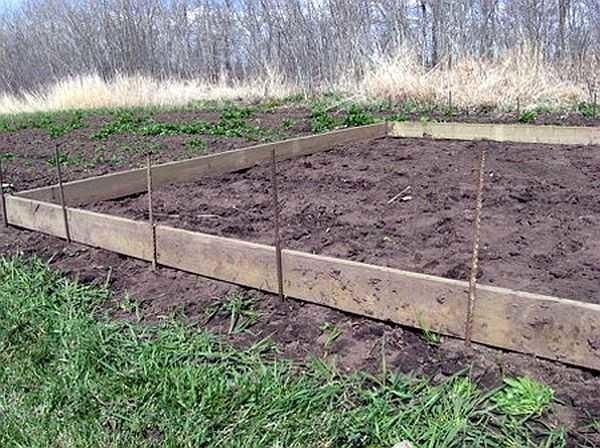
Put on the bars
On the armature on one side put on a cut piece of polypropylene pipe, bend it and put it on the same bar on the opposite side. We got the first arc. Do the same with all the others. We get arcs, installed every 50 cm. This is the frame of the greenhouse from polypropylene pipes.
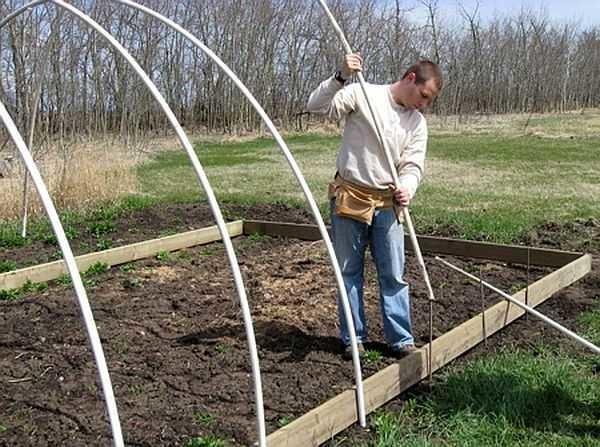
Now the pipes need to be fixed. Otherwise, they will just as easily be removed as we put them.
We take perforated metal tape, a screwdriver, self-tapping wood screws. Cut off a piece of tape, attach it to the frame near the pipe on one side, then on the other. You can screw in one or two more self-tapping screws closer to the pipe to hold the arc securely. To fix it more firmly, it is better to take the rebar corrugated, not smooth, you can also fix the PP pipe twice: almost at the ground and closer to the upper edge of the frame.
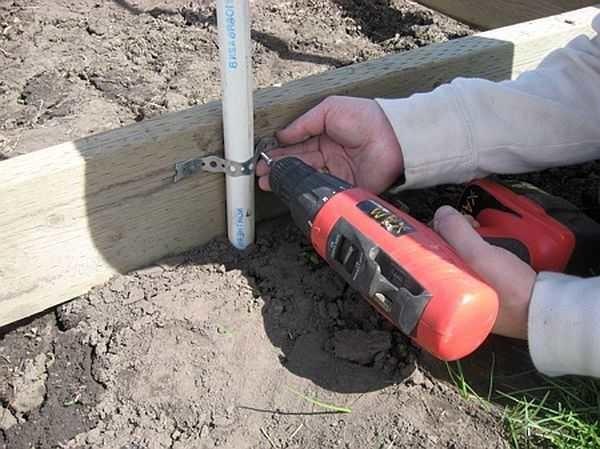
Now it is necessary to connect all the arcs with longitudinal pipes. They will give rigidity to the structure. If the greenhouse is small, only one longitudinal rib is enough. But it is more convenient when the sidewalls also have them.
A long piece of PVC pipe or a bar of small cross-section is tied at the top in the middle of the vault. It is attached with a plastic clamp to each arch. It will give the structure extra rigidity.
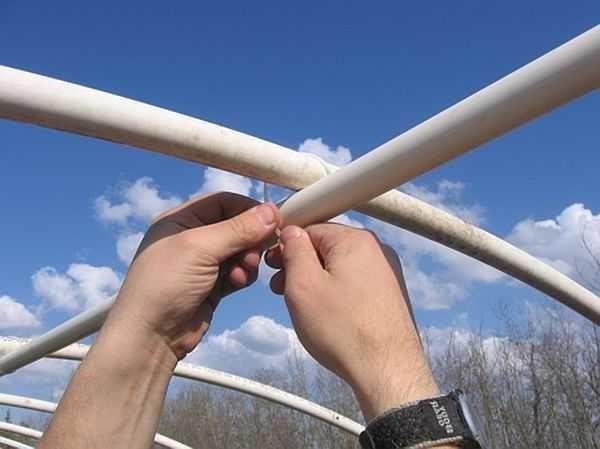
Making the doors
From a narrower board make a doorway in the middle of the first arch. Its height and width depends on how high your greenhouse turns out to be. But the width of the door should not be less than 80 cm: it will be inconvenient to walk.
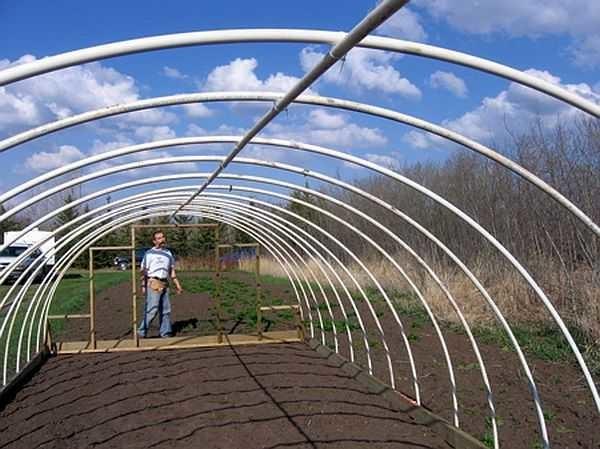
Now it’s a small matter: choose what to cover the greenhouse with. PVC pipes will be able to bear the film (any) or non-woven material (or both). After the material is fixed, you can consider the manufacture of a greenhouse with your own hands finished: you can plant seedlings. The height is sufficient for growing even high varieties of tomatoes or cucumbers and it is easy to make supports for gartering.
Greenhouse with the same technology
Interestingly, it is easy to build a greenhouse using the same technology. Only its dimensions will be smaller (the rebar can be thinner, its pieces are smaller), and the whole technology is similar.
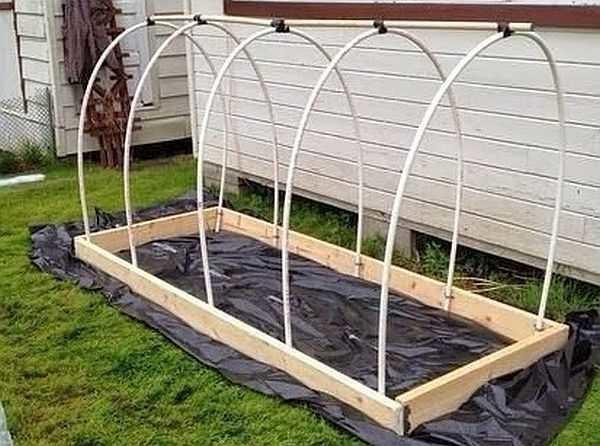
Almost in the same way built a greenhouse “Snowdrop”. With the only difference that the covering material in it is stitched, made in it waders, in which PVC pipes are threaded. After they are installed in the necessary places of agrovolokolokno, they are stuck into the ground. What is such a greenhouse convenient? That the shelter can be moved along the arch opening or closing the plants as needed.
Read about other types and kinds of greenhouses here.
Improvements
Most of all questions arise when organizing the entrance: it turns out to be the most problematic part. Here are two variants of its solution:
- Use thin plywood and a frame of timber.
You get a light, but reliable construction - Cover everything with plywood, and so that its edges do not tear the film, it is padded with felt, thin foam, or just a strip of soft fabric.
How else to make an entrance to the arch greenhouse .
To prevent the edges of the plywood from tearing the film, it is padded with something soft
How to attach the film to the pipes
How good are PVC pipe arcs? They are smooth, the film and spunbond on them do not tear. But how to attach the film to them? You can’t drive a nail into them, you can screw in a screw, but only when lying on the ground. In the frame it “plays” and the screw is not screwed into it. To fix the film there are special plastic clamps-latches. They are put on top of the film, covering part of the pipe.
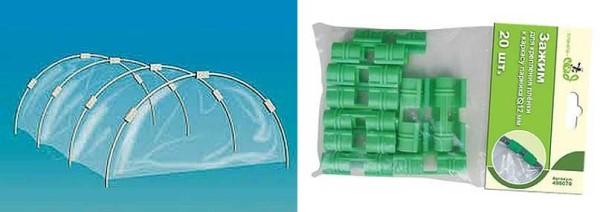
From a hose, plastic pipe, other improvised materials
Similar clips can be made from improvised materials. For small greenhouses from arcs, a piece of old hose cut lengthwise is suitable. For greenhouses, its rigidity may not be enough: sailing more. Then the clamp can be made from a piece of the same plastic pipe. It is also cut lengthwise, but you will have to cut off some of the width: PVC, and HDPE are still quite rigid, and just so they can not unfold. What part of the pipe to cut, you determine by experience, then the edges are treated with emery: so that they do not tear the film.
Not badly cope with the retention of the film fixers for pipes, which are used in the installation of pipelines in houses. You will have to break off its leg, but otherwise it is very good.
More people use stationery binders of the right size. This device holds quite well, but because it is metal, there is a possibility that in strong winds the film will tear. To prevent this from happening, you can put a piece of cloth.
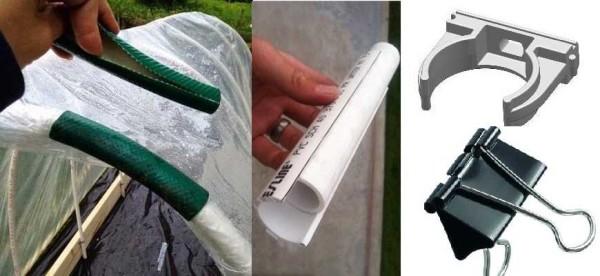
And another way that you can attach the film to the arc of the greenhouse: take double-sided tape and stick it on one side of the pipe. Then, gradually removing the protective film, glue the film to it. This is an option for cheap polyethylene film: it will be impossible to remove it. Another point: glue the film should not be glued to the very bottom: after all, you may need to ventilate the greenhouse.
For convenient ventilation film cut off longer than required centimeters to 20-30 on each side (if the length of the arc, for example, 2 meters, the film will need at least 2.5). Take a bar, wrap the film around it and nail it down. Now, if the film needs to be lifted, it is screwed onto the bar, and it is fixed (or simply thrown on the roof, tying a rope to be able to pull back). Only the bar should be well-treated, without sharp edges. This way it will not tear the film.
About auto irrigation systems read in the article “Auto irrigation with your own hands”
Arcs for a greenhouse from profiles
Greenhouse under the film can be not only from a polymer pipe. You can use galvanized profiles for outdoor use. They are light, due to the ribs have a sufficient degree of rigidity. Greenhouse with a galvanized profile can be covered with any material, except, perhaps, glass: it is too heavy.
To make an arc of the profile, its sides are cut with a bolgar every 20-30 cm, leaving the middle part intact. On the ground outline the arc that needs to be formed (a semicircle can be drawn with a piece of rope and a pencil tied to one side, if you work on a concrete site or a sharp peg that scratches the turf or ground. The cut profile is laid on this pattern, tucked in the places of cuts. Then take a screwdriver and self-tapping screws (fleas), fasten in places where the side parts intersect, first on one side, then on the other.
How it looks like in person, see the video.
On such arcs you can already attach polycarbonate. But the design is still not rigid enough to walk on it.
Video on how to make arcs for a greenhouse with polycarbonate from wood
This method is available to experienced carpenters. But the result is excellent: not just reliable, but also beautiful. Very interestingly invented fastening system: the polycarbonate is not fixed intentionally, but moves along the guides, opening and closing the side edges. The design is more complex, but also more reliable.
Economical greenhouse with heating
How to make a year-round greenhouse, and spend a little on its heating? One gardener came up with the idea of burying the greenhouse in the ground. One of the very rational options, see the following video.
Greenhouses with their own hands are made of different materials and different designs, but the priority is the arch structure. It is easier to build, and when working does not interfere, allows you to ventilate if necessary.

